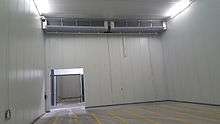Controlled atmosphere
A controlled atmosphere is an agricultural storage method in which the concentrations of oxygen, carbon dioxide and nitrogen, as well as the temperature and humidity of a storage room are regulated. Both dry commodities and fresh fruit and vegetables can be stored in controlled atmospheres.


Dry commodities
Grains, legumes and oilseed are stored in a controlled atmosphere primarily to control insect pests.[1] Most insects cannot survive indefinitely without oxygen or in conditions of raised (>30%) carbon dioxide.[2] Such controlled atmosphere treatments of grains may take several weeks at lower temperatures (<15 °C). A typical schedule for complete disinfestation of dry grain (<13% moisture content) with carbon dioxide at approximately 25 °C is a concentration above 35%(v/v) carbon dioxide in air for at least 15 days.[3] These atmospheres can be created either by:
- Adding pure carbon dioxide or nitrogen, or the low oxygen exhausts of hydrocarbon combustion, or
- using the natural effects of respiration (by grain, molds or insects) to reduce oxygen and increase carbon dioxide (Hermetic storage).[4]
Fruit and vegetables
The method is most commonly used on apples and pears, where the combination of altered atmospheric conditions and reduced temperature allow prolonged storage with only a slow loss of quality.[5][6]
The long-term storage of vegetables and fruit involves inhibiting the ripening and ageing processes, thus retaining flavor and quality. Ripening is delayed by reducing the level of oxygen and increasing that of carbon dioxide and nitrogen in the cool cell so that the respiration is reduced. Normal atmosphere consists of approximately 78% nitrogen, 21% oxygen, 0.3% carbon dioxide and smaller amounts of some other gasses. In controlled atmosphere the oxygen is reduced to 1.5–2% by replacing it with nitrogen and a little bit of carbon dioxide, which is produced by fruits. Under controlled atmosphere conditions the quality and the freshness of fruit and vegetables are retained, and many products can be stored for 2 to 4 times longer than usual.
History
Franklin Kidd and Cyril West of Cambridge University did the basic research into fruit respiration and ripening leading to the first commercial facility in 1929. By 1960, there was capacity for 4 million bushels of apples in the US and by the 1980s, capacity exceeded 100 million bushels.[7]
References
- Cao, Yu; Xu, Kangkang; Zhu, Xiaoye; Bai, Yu; Yang, Wenjia; Li, Can (June 25, 2019). "Role of Modified Atmosphere in Pest Control and Mechanism of Its Effect on Insects". Frontiers in Physiology. 10. doi:10.3389/fphys.2019.00206 – via Frontiers.
- https://hortscans.ces.ncsu.edu/uploads/c/o/controll_51a626feac43f.pdf
- Annis, P.C. and Morton, R. (1997). "The acute mortality effects of carbon dioxide on various life stages of Sitophilus oryzae". Journal of Stored Products Research. 33 (2): 115–124. doi:10.1016/S0022-474X(96)00050-1.CS1 maint: multiple names: authors list (link)
- Annis P.C. and Banks H.J. (1993). "Is hermetic storage of grains feasible in modern agricultural systems?" In est control and sustainable agriculture Eds S.A. Corey, D.J. Dall and W.M. Milne. CSIRO, Australia. pp. 479–482. ISBN 0 643 05426 X
- Washington Apple Commission. Bestapples.com. Retrieved on 2020-03-01.
- Controlled Atmosphere Is The Key To Keeping Apples All Year Round : The Salt. NPR (2018-11-26). Retrieved on 2020-03-01.
- Sigler, Derreck (28 July 2011). "CA storage has become staple of the fruit industry". Fruit Growers News. Retrieved 25 July 2017.